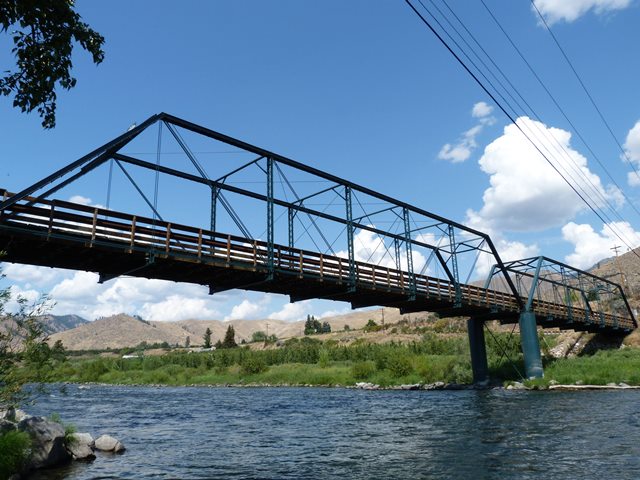We Recommend:
Bach Steel - Experts at historic truss bridge restoration.
BridgeHunter.com Phase 1 is released to the public! - Visit Now
West Monitor Bridge

Primary Photographer(s): Nathan Holth
Bridge Documented: August 21, 2014
Rural: Chelan County, Washington: United States
Metal 7 Panel Pin-Connected Pratt Through Truss, Fixed and Approach Spans: Wood Stringer (Multi-Beam), Fixed
1907 By Builder/Contractor: Puget Sound Bridge and Dredging Company of Seattle, Washington
2011
140.0 Feet (42.7 Meters)
312.0 Feet (95.1 Meters)
14.4 Feet (4.39 Meters)
2 Main Span(s) and 2 Approach Span(s)
81197000000000

View Information About HSR Ratings
Bridge Documentation
View Archived National Bridge Inventory Report - Has Additional Details and Evaluation
View Historic Structure Reports For This Bridge
The pin-connected Pratt truss bridge was the typical metal bridge of the late 1800s, and numerous such bridges were built during this period across the country. However, Washington State has very few examples. Bridges of this type are rapidly disappearing nationwide, so any surviving examples are significant, but the bridge is highly significant in the context of Washington State which has so few pin-connected highway truss bridges. Fortunately its high level of significance has been recognized and the bridge is currently preserved.
When compared to pin-connected Pratt through truss bridges elsewhere in the country, this bridge is traditionally composed, with no particularly unusual details for this bridge type. In the nationwide context of the bridge type, this is a late example of its type, and parts and design details had become more standardized. Washington State does not have highway truss bridges from the earlier period of experimentation in metal truss design, such as the 1880s.
This bridge has been comprehensively rehabilitated. In general, the rehabilitation is of good quality which represents a compromise between the need to provide load capacity for vehicular use, while maintaining the most important aspects of original material and design. A few alterations should be noted. Despite the availability of companies like Bach Steel who can do riveting, any rivets replaced on this bridge during rehabilitation were replaced with bolts. Also, an interesting approach to strengthening the top chord and end post was undertaken by bolting plate to the inside of the channels. Aside from the bolts on the side of the channel, this alteration does not adversely affect the visual appearance of the bridge. One source stated that the floorbeams had been replaced, however the floorbeams seen on the bridge today are American Standard Beams and have Carnegie brands on them indicating this source was incorrect. Original floor beams were retained on the bridge, which is nice to see. Original railings do not remain on the bridge, a problem pre-dating the most recent comprehensive rehabilitation.
The deck was replaced during rehabilitation.
An interesting feature of rehabilitation here is that stoplights were added to control the flow of one-lane traffic over the bridge. Its an unusual layout because of the intersection at the southwest end of the bridge, therefore the stoplight layout is designed to accommodate traffic coming from two locations at the southwest end.
![]()
Photo Galleries and Videos: West Monitor Bridge
Bridge Photo-Documentation
Original / Full Size PhotosA collection of overview and detail photos. This gallery offers photos in the highest available resolution and file size in a touch-friendly popup viewer.
Alternatively, Browse Without Using Viewer
![]()
Bridge Photo-Documentation
Mobile Optimized PhotosA collection of overview and detail photos. This gallery features data-friendly, fast-loading photos in a touch-friendly popup viewer.
Alternatively, Browse Without Using Viewer
![]()
CarCam: Southwestbound Crossing
Full Motion VideoNote: The downloadable high quality version of this video (available on the video page) is well worth the download since it offers excellent 1080 HD detail and is vastly more impressive than the compressed streaming video. Streaming video of the bridge. Also includes a higher quality downloadable video for greater clarity or offline viewing.
![]()
Maps and Links: West Monitor Bridge
Coordinates (Latitude, Longitude):
Search For Additional Bridge Listings:
Bridgehunter.com: View listed bridges within 0.5 miles (0.8 kilometers) of this bridge.
Bridgehunter.com: View listed bridges within 10 miles (16 kilometers) of this bridge.
Additional Maps:
Google Streetview (If Available)
GeoHack (Additional Links and Coordinates)
Apple Maps (Via DuckDuckGo Search)
Apple Maps (Apple devices only)
Android: Open Location In Your Map or GPS App
Flickr Gallery (Find Nearby Photos)
Wikimedia Commons (Find Nearby Photos)
Directions Via Sygic For Android
Directions Via Sygic For iOS and Android Dolphin Browser
USGS National Map (United States Only)
Historical USGS Topo Maps (United States Only)
Historic Aerials (United States Only)
CalTopo Maps (United States Only)


